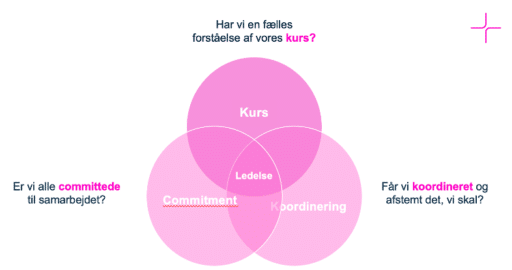Agile ways of organizing and working have become commonplace in most organizations. In some places as the primary form of organization and work, but in many places in conjunction with more classic hierarchical forms of organization. There are two major ideals and driving forces at play in this development. Roughly speaking, you could call them "the functionalist" and "the humanist". The functionalist ideal is about the fact that both private and public companies today face demands and expectations for a high rate of change and development in order to deliver products and services that are based on the needs and expectations of customers and citizens. The humanistic ideal is about well-being, psychological work environment and an increasing expectation of less hierarchy and more influence and flexibility in work (Grant & Russell, 2020). Agile ways of organizing and working have great potential to promote both functionalist and humanist ideals. There is a strong focus on working in new ways, embracing agile values and principles and implementing Scrum or SAFe - to name a few. Agile ways of working and practices are often in place, but agile leadership is lagging behind. What is agile leadership? And what does it mean for you as a leader? The research and practice literature provides little concrete guidance (Theobald et. al. 2020). Basically, agile leadership can be divided into three elements.

Curious for more? Download our agile management e-book
In this e-book, you will learn what characterizes agile leadership, not as a one-sided and simplistic leadership skill, but as the ability to balance your leadership in the context in which you lead, and that this form of leadership is not only relevant in pure agile organizations, but for any leader who must navigate in a world of increasing complexity and uncertainty.
1. Leading the agile values and principles
As a leader in an agile context, it's essential that you understand, promote and lead on agile values and principles. This means focusing more on collaboration, managing change and creating value early and continuously - and less on control, extensive documentation and sticking to a plan. To succeed as an agile leader, you also need to trust that the task will get done when employees and teams are given the right environment and mandates to get the job done (Theobald et. al. 2020).
The leader diagnoses the culture
One of the most useful tools for diagnosing an organizational culture is the OCAI, which stands for Organizational Culture Assessment Instrument. OCAI is based on the Competing Values Framework theory. So let's start with that.
The Competing Values Framework serves as a basic framework of understanding and points out that all organizations are faced with conflicting values and logics. Leadership therefore becomes a balancing act of navigating paradoxes and cross-pressures. Everyday life for leaders is not either-or, but always a balancing act between both-and. The theory helps to understand how to balance operations and development, relationships and results.
As a model, the Competing Values Framework is built around two axes. The vertical axis illustrates a continuum from 'Flexible' to 'Focused' and the horizontal axis from 'Inward-looking' to 'Outward-looking'. In total, there are four fields that are in opposition to each other in pairs, but at the same time, they are each other's prerequisites. As a leader, you need to meet organizational needs at both ends of the axes.
The way to deal with these conflicting demands is paradox management. Theoretically based on the Competing Values Framework, it's an approach where the leader navigates the competing values and needs that every organization holds. The goal is to become aware of what the organization assigns attention to and to develop a desired practice (and culture) for each of the four fields. By integrating conflicting considerations and consciously dialing up and down different categories of values and practices, leaders can increase the chances of developing a thriving culture.
Agile leadership is about constant value creation
Agile leadership includes different roles; some are responsible for process, others for product, deliverables or skills development. But how else can you understand what agile leadership is? If we look towards the agile manifesto - and especially the underlying agile principles, we see indications of what leaders need to succeed at: "Build projects around motivated individuals. Give them the environment and support they need and trust them to get the job done."
Leadership is therefore about trusting that tasks will get done when employees and teams are given the right environment and mandates to do them. Leadership here is about supporting, engaging and motivating employees and teams. Often the focus is on doing agile, while being agile is often overlooked or washed out by the existing culture. The agile leader must focus on promoting an agile culture. This is done by strategically targeting the development of the following characteristics:
- Create opportunities and remove obstacles for the team
- Trust autonomous teams or networks of teams to deliver
- Coordinate work through structured iterative processes based on the customer
- Transparency and continuous improvement in products, services and working methods.
Agile leadership includes a high degree of distributed decision-making power to different roles, while all leaders are role models for living the agile principles and mindset. Leadership is very much about helping each other to perform together towards common goals that create value for the user or customer (Modi & Strode, 2020).
2. Agilely adapt your leadership to the circumstances
The second element of agile leadership is about adapting your leadership to the task at hand, which is a necessary skill to succeed as a leader. Today and in the future. As an agile leader, you need to adapt your approach to leadership quickly, easily and flexibly. You must also have the ability and courage to read and respond to changing circumstances with a broad action and leadership repertoire(E-book: Agile leadership - balancing the ability to both support and take control). You need to be able to use opposing leadership approaches, regardless of personal preferences. It is therefore important to be aware of your own leadership style and preferences, including how your leadership can support agile teams and how your own behavior can inhibit or promote trust and collaboration.
Both-and, not either-or!
3. Leadership happens through direction, coordination and commitment
The final element of agile leadership is that leadership happens through direction, coordination and commitment. Leadership in an agile context is distributed across multiple formal and informal leaders (e.g. Scrum Masters and Product Owners) and largely distributed to the self-organized team. If you want to create leadership across all these actors, you as a leader have a special responsibility to ensure that direction, coordination and commitment are created. In other words, it's not about focusing on who is doing the leading, but rather on how leadership is produced together. In short, leadership in an agile context occurs when people working together in teams create direction, coordination and commitment. This may or may not include formal leaders (Drath et. al. 2008).
An organization filled with leadership
- Course: create a common course and direction for the team, area or organization
- Coordination: coordin ate the many efforts so that they all pull in the same direction
- Commitment: create community and a committed practice among everyone in the organization.

Demand for the agile leader
Sources
- Drath, W. H, Cynthia D., McCauley, C. J,. Palus, E. V.V. , Patricia M.G, O'Connor, J. B. M. (2008). Direction, alignment, commitment: Toward a more integrative ontology of leadership. Elvevier. Leadership Quarterly.
- Grant, C. & Rusell, E. (2020). Agile Working and Well-Being in the Digital Age. Palgrave MacMillan.
- Kaiser, R. B. (2020), "Leading in an unprecedented global crisis: the heightened importance of versatility". Consulting Psychology Journal: Practice and Research, Vol. 72
- Kaiser, R.B., &. Overfield, D. V. (2011). Strengths, strengths overused, and lopsided leadership. Consulting Psychology Journal Practice and Research.
- Modi, S., & Strode, D. (2020). Leadership in Agile Software Development: A Systematic Literature Review. ACIS 2020 Proceedings. 55.
- Theobald, S., Prenner, N., Krieg, A., Schneider, K. (2020). Agile Leadership and Agile Management on Organizational Level - A Systematic Literature Review. Springer Nature Switzerland.
The authors of the article:

Claus Elmholdt
Professional Director, Founder Cand.Psych.Aut. & Ph.d. Associate Professor in Management and Organizational Psychology,

Laust Søndertoft Pedersen
Senior Consultant, Cand.psych & Industrial PhD scholar

Mette Tange Vestergaard
Senior Consultant, Cand.scient.pol

Do you want to be better at:
- Take a coaching role and create a good feedback culture
- Handle difficult conversations and conflicts when they arise
- Avoid the most common pitfalls as a new manager
- Adapt your leadership style to the needs of the situation
- Involve and engage employees and teams
- Work strategically to create high-performing teams
- Communicate the right messages that create engagement and followership
- Be more confident in your leadership role
- Translate strategy into concrete behavioral changes
- Dealing with resistance and softening change
- Reflect and further develop your personal leadership






